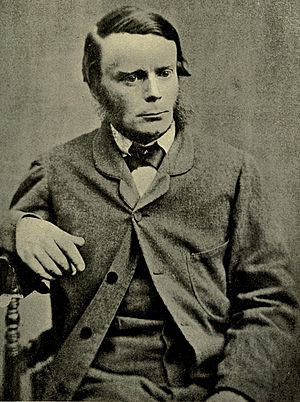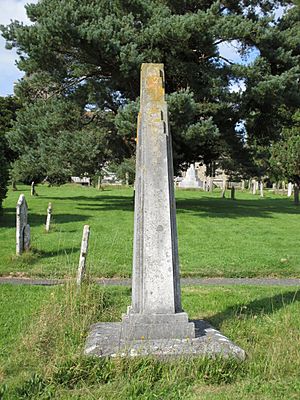Henry Kingsley facts for kids
Quick facts for kids
Henry Kingsley
|
|
|---|---|

Kingsley, c. 1870
|
|
| Born | 2 January 1830 Northamptonshire, England |
| Died | 24 May 1876 (aged 46) Sussex, England |
| Signature | |
Henry Kingsley (born January 2, 1830 – died May 24, 1876) was an English writer. He was the brother of a more famous author, Charles Kingsley. Henry Kingsley wrote many popular novels during his lifetime.
Contents
About Henry Kingsley
Henry Kingsley was born in Barnack Rectory, Northamptonshire, England. His father was Rev. Charles Kingsley. The Kingsley family had many writers. Besides Henry and Charles, his cousin Mary Kingsley was an explorer and writer. His aunt, Charlotte Kingsley Chanter, wrote about plants and also wrote novels. His brother George Kingsley was a traveler and writer.
Early Life and Education
Henry spent his childhood in Clovelly and Chelsea, London. He went to King's College School and then Worcester College, Oxford. However, he left Oxford without finishing his studies.
Adventures in Australia
Henry received some money from a relative. This allowed him to leave Oxford without debt. He decided to move to Australia. He arrived in Melbourne in December 1853. In Australia, he tried his hand at gold-digging. Later, he joined the mounted police.
For a while, Kingsley had very little money. He carried his swag (a bedroll for travelers) from one farm to another. A man named Philip Russell said in 1887 that he hired Kingsley at his farm, Langa-Willi. Russell also said that Kingsley started writing his famous book, The Recollections of Geoffry Hamlyn, there.
Becoming a Novelist

Henry Kingsley returned to the United Kingdom in 1857. After that, he focused on writing books. He wrote several well-known novels. These included Geoffry Hamlyn (1859), which was set in England and Australia. Another important book was Ravenshoe (1861), which many people consider his best work. He also wrote Austin Elliot (1863) and The Hillyars and the Burtons (1865).
Henry Kingsley married Sarah Maria Haselwood on July 19, 1864. In 1869, he moved to Edinburgh to work as an editor for a newspaper called the Daily Review. However, he soon left that job. In 1870, he became a war correspondent for the same paper during the Franco-German War. This meant he reported on the war from the battlefield.
Other Works
Kingsley published many other books. Some of these include:
- Leighton Court (1866)
- Mademoiselle Mathilde (1868)
- Tales of Old Travel Re-narrated (1869)
- Stretton (1869)
- The Boy in Grey (1871)
- Hetty and other Stories (1871)
- Old Margaret (1871)
- Hornby Mills and other Stories (1872)
- Valentine (1872)
- The Harveys (1872)
- Oakshott Castle (1873)
- Reginald Hetherege (1874)
- Number Seventeen (1875)
- The Grange Garden (1876)
- Fireside Studies (Essays) (1876)
- The Mystery of the Island (1877)
Later Life and Death
Kingsley and his wife moved to Cuckfield, Sussex, in late 1874. Henry Kingsley died there on May 24, 1876. He passed away from cancer of the tongue.

